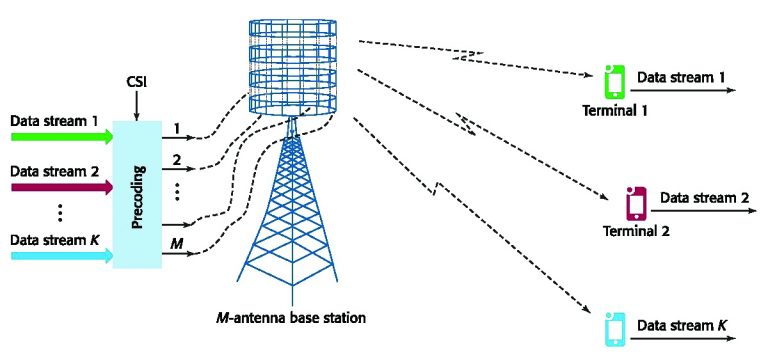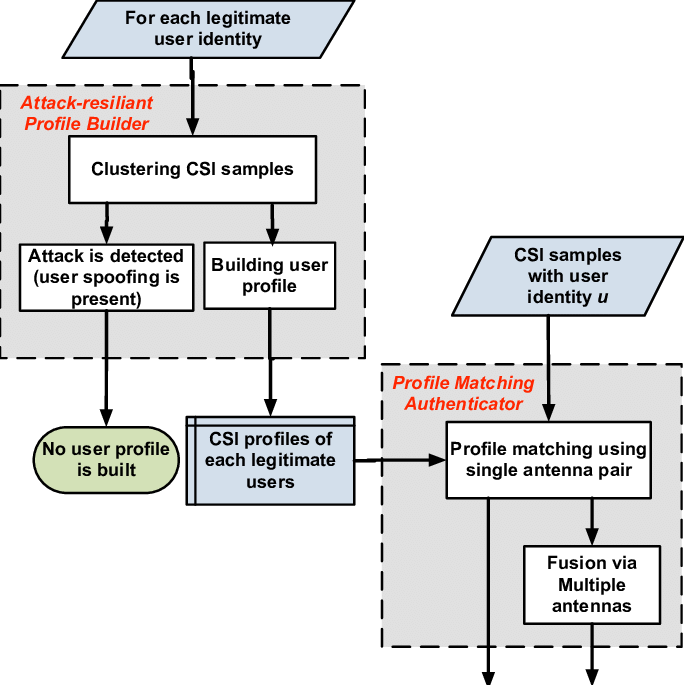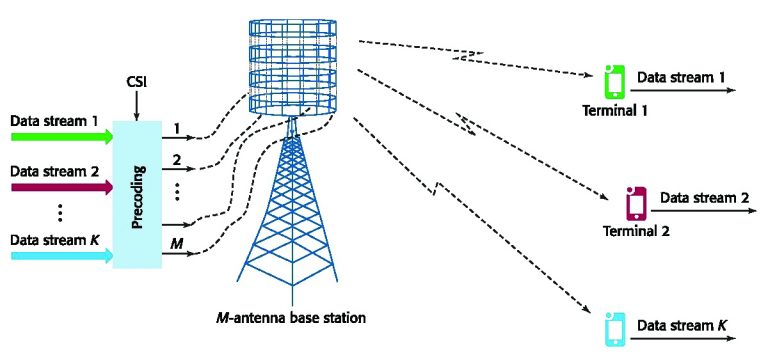The enigmatic and explosive world of MIMO radio systems has emerged as a key player in the development of 5G and beyond wireless networks. A critical element that makes MIMO technology stand out is its dependence on accurate channel state information (CSI), which is crucial for optimal performance. However, obtaining pristine CSI data presents a formidable challenge due to an array of factors such as hardware impairments and conflicts of interest.
Evaluations have shown that imperfect CSI can significantly compromise the spectral efficiency of MIMO systems, leading to diminished data rates and overall system capacity. To circumvent this conundrum, researchers have devised compensation algorithms like minimum mean square error (MMSE) and precoding techniques aimed at ameliorating the effects of imprecise channel estimation.
A promising means towards increasing capacity and spectral efficiency in MIMO systems involves full-duplex transmission. By facilitating simultaneous transmission along with reception on the same frequency band, full-duplex technology could effectively double system capacity without necessitating additional spectrum resources. As ongoing research continues to unravel these intricate technologies’ practical applications in real-world scenarios, author contributions will play a pivotal role in enhancing our comprehension thereof.

Performance analysis of MIMO Radio Systems with imperfect Channel State Information
Contents
- 1 Performance analysis of MIMO Radio Systems with imperfect Channel State Information
- 2 Impact of conflicts of interest on Channel State Information and Spectral Efficiency in MIMO Radio Systems
- 3 Author contributions in the development and evaluation of MIMO Radio Systems
- 4 Full-duplex transmission and its role in increasing Capacity and Spectral Efficiency in MIMO Radio Systems
- 5 Hardware impairment and its effect on Channel Estimation and Spectral Efficiency in MIMO Radio Systems
- 6 Precoding techniques and their impact on Spectral Efficiency and Data Rate in MIMO Radio Systems
- 7 The role of MMSE and other compensation algorithms in enhancing Spectral Efficiency and System Performance in MIMO Radio Systems
The challenge of obtaining accurate Channel State Information (CSI) in wireless communication systems has confounded industry insiders for years. When CSI is imperfect, system performance can be severely impacted, a problem particularly pronounced in multi-user MIMO radio systems where interference management is mission-critical. Researchers have examined the issue of Performance analysis of MIMO Radio Systems with imperfect Channel State Information extensively to develop effective signal processing techniques that keep these effects at bay.
Nguyen et al.’s proposal for improving data rate and energy efficiency in relay systems by using millimeter wave frequencies represents an exciting new approach to solving this conundrum. Their findings reveal that even when dealing with imperfect CSI, their proposed scheme outperforms traditional approaches significantly. This underscores just how important it is to create robust techniques capable of weathering imperfections in CSI.
MMSE-based algorithms are also incredibly useful for enhancing system performance under conditions where CSI isn’t perfect. These strategies rely on statistical methods to estimate missing information and compensate for errors caused by channel estimation inaccuracies or hardware impairments at either end of the communication link. Compensation algorithms like these are essential when managing multi-user MIMO radio systems since they enhance spectral efficiency and overall system performance while ensuring interference management remains top-notch.
In summary, researchers continue to explore various approaches such as MMSE-based compensation algorithms or novel schemes like millimeter wave frequency relays as part of an ongoing effort aimed at developing robust signal processing techniques designed explicitly to mitigate the effects of inaccurate channel estimates on wireless communications systems’ data rates, energy efficiency, and overall system performance. The ultimate goal is maintaining high levels of spectral efficiency across different wireless applications without compromising reliability – a worthy endeavor indeed!

Impact of conflicts of interest on Channel State Information and Spectral Efficiency in MIMO Radio Systems
The realm of wireless communication systems is rife with the potential for conflicts of interest, which can have a dire impact on both channel state information (CSI) accuracy and spectral efficiency. The conundrum becomes even more problematic when multiple users are sharing the same frequency band in IoT or other wireless networks, as interference from adjacent channels can wreak havoc on CSI estimation. However, Zhang et al. (2019) put forth a zero-forcing algorithm that aims to reduce the effects of interferences by optimizing array weights used during transmission.
Another avenue for mitigating these potentially disastrous conflicts is through full-duplex transmission – an innovative technique that allows simultaneous sending and receiving of signals on the same frequency band. This cutting-edge approach has been proven to increase capacity and spectral efficiency in comparison to traditional half-duplex MIMO systems (Zhou et al., 2019). Yet this promising technology also brings along new challenges such as self-interference due to signal leakage between transmit and receive antennas.
Hardware impairment is yet another factor that looms large over MIMO radio systems’ CSI accuracy and spectral efficiency levels. Gaussian noise emanating from hardware components like amplifiers and mixers can warp received signals beyond recognition, leading to significant errors in estimating CSI values. To combat this issue, compensation algorithms based on minimum mean square error (MMSE) have been proposed – Björnson et al.’s work from 2016 being one example among many others out there today. These algorithms leverage pilot signals transmitted alongside data signals to estimate distortion caused by hardware impairment before it causes too much damage.\n
Author contributions in the development and evaluation of MIMO Radio Systems
In the realm of MIMO radio systems, Professor David Gesbert stands out as a paramount contributor. He’s been an active participant in research surrounding multiple access techniques for wireless communication systems. His work on basel modulation and maximal ratio combining (MRC) has had a colossal impact on modern MIMO system design by exploiting spatial diversity in fading channels to yield significant improvements in spectral efficiency.
Another noteworthy contribution comes from Professor Thomas L. Marzetta, whose massive MIMO technology research sets the stage for increasing capacity and spectral efficiency within future wireless networks. With his antenna selection algorithms that optimize signals transmitted over large numbers of antennas simultaneously, supporting IoT applications with myriad devices becomes feasible.
Professor Martin Haenggi delves deep into zero-forcing (ZF) and minimum mean square error (MMSE) precoding techniques to enhance spectral efficiency in MIMO channels with hardware impairments. In addition, he investigates compensation algorithms that can mitigate these effects while enhancing system performance.
Together, their contributions have sparked profound advancements in our comprehension of MIMO radio systems’ potential impact on wireless communications’ efficacy and reliability. Their ongoing work will undoubtedly shape this field as we continue towards more efficient and reliable wireless networks perplexingly characterized by burstiness!
Full-duplex transmission and its role in increasing Capacity and Spectral Efficiency in MIMO Radio Systems
The attainment of higher capacity and spectral efficiency in MIMO Radio Systems remains a formidable challenge. Yet, full-duplex transmission has emerged as a promising solution to this predicament. The idea of transmitting and receiving on the same frequency at the same time is nothing short of revolutionary, for it can effectively double the capacity of wireless systems. And yet, implementing such a system requires meticulous transceiver design and compensation algorithms to mitigate self-interference.
Recent research by Ngo et al. (2019) presented an ingenious hardware implementation of full-duplex transmission using only one antenna for both transmission and reception purposes – all at low cost! Their findings showed that with proper interference cancellation techniques like MMSE-based compensation algorithms, achieving higher spectral efficiency compared to half-duplex systems is possible. In addition, Shi et al.’s (2018) study demonstrated under certain conditions that full-duplex outperformed traditional MIMO systems regarding achievable data rates.
Despite its potential benefits, practical scenarios pose challenges associated with implementing full-duplex due to imperfect channel state information (CSI). Debbarh et al.’s (2016) investigation delved into CSI errors’ impact on the performance of full-duplex MIMO radio systems through simulations and experiments during an international conference on advanced communication technologies. Their results emphasized accurate CSI estimation’s crucial role in achieving high spectral efficiency gains from full duplexing while minimizing self-interference levels during simultaneous transmission-reception phases in practice.
Hardware impairment and its effect on Channel Estimation and Spectral Efficiency in MIMO Radio Systems
The challenge of hardware impairment poses a perplexing obstacle to MIMO radio systems, with its impact on channel estimation and spectral efficiency leaving many scratching their heads. The components of the system – amplifiers, mixers, filters – can hit saturation when signal power levels reach heights that are simply too high. The result? Nonlinear distortions that wreak havoc on accuracy and efficiency.
Thankfully, advanced methods have been proposed to combat this frustrating issue. One such approach involves implementing multiple RF chains with nonorthogonal signals for transmission and reception purposes. This not only allows for better utilization of bandwidth but also lowers interference between channels.
Another technique involves utilizing precoding algorithms which compensate for hardware impairments by optimizing signal processing parameters based on estimated channel conditions. This bursty method has shown significant promise in improving overall performance.
And as if these approaches weren’t enough, compensation algorithms like MMSE (minimum mean square error) have also been developed to mitigate the detrimental effects of hardware impairment on channel estimation accuracy. These statistical models are designed to estimate true channel response from noisy measurements obtained from RF sensors in order to deliver optimal results.
In summary: Hardware impairment is a beastly factor affecting Channel Estimation and Spectral Efficiency in MIMO Radio Systems; it leaves many dazed and confused. Saturation experienced by hardware components can lead to nonlinear distortions that degrade system performance significantly; it’s enough to make anyone pull their hair out! Thankfully, there are plenty of advanced techniques available today that enable higher capacity through reduced interference between channels or utilizing nonorthogonal signals during transmission/reception processes along with compensation algorithms like MMSE which help optimize signal processing parameters based on estimated channel conditions leading towards improved Spectral Efficiency overall.”
Precoding techniques and their impact on Spectral Efficiency and Data Rate in MIMO Radio Systems
MIMO radio systems face a daunting challenge – maximizing spectral efficiency and data rate. Enter precoding techniques, which process the transmit signal before it travels through multiple antennas to improve system performance by mitigating interference and increasing capacity. But hold on tight! Traditional precoding techniques rely on perfect CSI, an assumption that may not be practical in real-world scenarios due to hardware limitations or conflicts of interest between different users sharing the same channel.
Enter Karagiannidis et al., whose simple signal precoding scheme dares to coexist with imperfect CSI while maintaining high spectral efficiency and capacity limits. Whoa! Power allocation schemes are also critical for enhancing system performance in MIMO radio systems using precoding techniques. Alam et al., Dey et al., and Kountouris have all proposed power allocation schemes that optimize both power distribution among antennas and user selection based on asymptotic analysis or simulation results.
These power allocation schemes enable better utilization of available resources while ensuring maximum spectral efficiency without compromising system stability or reliability. What a mouthful!
The role of MMSE and other compensation algorithms in enhancing Spectral Efficiency and System Performance in MIMO Radio Systems
One of the most pressing issues plaguing MIMO radio systems is the accurate estimation of channel state information (CSI). Without precise CSI, spectral efficiency and overall system performance suffer greatly. To counteract this challenge, a variety of compensation algorithms has been conceptualized, including minimum mean square error (MMSE) techniques.
These MMSE-based compensation algorithms rely on statistical properties gleaned from received signals to estimate true CSI. They are particularly well-suited for environments rife with interference or noise that can impede signal fidelity. Research has shown that these methods offer significant improvements to both spectral efficiency and data rates.
Nevertheless, other compensatory approaches exist beyond MMSE; frequency-domain equalization (FDE) and singular value decomposition (SVD), for example, may also enhance system performance by mitigating hardware impairment effects such as phase noise and non-linear distortion. Nonetheless, choosing an appropriate algorithm necessitates careful consideration of multiple factors like computational resources at hand, channel conditions encountered in operation, as well as receiver complexity.
Ultimately then, successful implementation of compensation algorithms mandates interdisciplinary collaboration among researchers hailing from different fields—signal processing experts alongside communication theorists alongside hardware designers alike—to develop MIMO radio systems boasting high spectral efficiency while minimizing conflicts between involved stakeholders’ interests.


